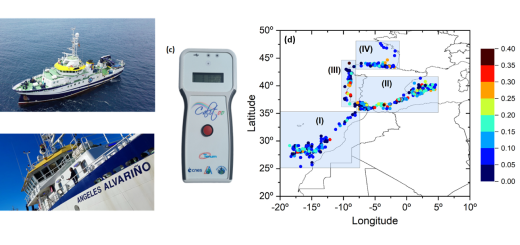PhD Presentation of África Barreto-Velasco
 Dr. África Barreto-Velasco defended her PhD Thesis entitled “DETERMINATION OF EARTH’S SURFACE TEMPERATURE AND EMISIVITY IN THE CANARY ISLANDS USING THERMAL-INFRARED RADIOMETRY” ON December 12 at the University of La Laguna, earning the top rating of “Cum Laude” .This thesis has been supervised by Dr. Manuel Perez Arbelo from the Department of Fundamental Physics, Electronics and Systems, at the Physical Sciences Faculty (ULL) as part of the PhD program in Physics and Computer Science.
Dr. África Barreto-Velasco defended her PhD Thesis entitled “DETERMINATION OF EARTH’S SURFACE TEMPERATURE AND EMISIVITY IN THE CANARY ISLANDS USING THERMAL-INFRARED RADIOMETRY” ON December 12 at the University of La Laguna, earning the top rating of “Cum Laude” .This thesis has been supervised by Dr. Manuel Perez Arbelo from the Department of Fundamental Physics, Electronics and Systems, at the Physical Sciences Faculty (ULL) as part of the PhD program in Physics and Computer Science.
Dr. Barreto now works at the Izaña Atmospheric Research Center (AEMET) on the characterization and validation of a new instrument developed by the company Cimel Electronique, in collaboration with this company. This new prototype (“Lunar Cimel”) is an especially designed photometer for measuring aerosol optical properties and water vapor during the night through direct moon observations. Dr. Barreto has designed and implemented the new calibration algorithms using observational techniques and modeling for night time measurements of aerosols and water vapor, and has carried out the corresponding validations. It is expected this new instrument will be part of the AERONET network in the near future.
PhD Thesis abstract
Land surface temperature (LST) is a key factor in the water and energy balance between surface and atmosphere, as well as being essential to validate and improve global atmospheric models. However, the accuracy in LST determination is far from being suitable to be included in climate or meteorological models, which require a precision of ±0,5 K. In this study we have introduced several test areas located in Tenerife (Canary Islands) to deal with the problem of inaccuracies in LST and land surface emissivity (LSE). This study has been developed by using an extensive calibration procedure including all the radiometric instruments involved in LST and LSE determination. The location of the selected areas at high altitude above sea level assures a minimum impact of the atmosphere on remote data. Furthermore, they are homogeneous in terms of both their composition and surface coverage. All these properties provide an excellent opportunity to study these problems more in depth. The selected areas are nine volcanic coulees located in La Caldera de Las Cañadas del Teide and the wide forest area constituted mainly by the endemism pinus canariensis. LSE was obtained for those areas using the box method and a multiband field radiometer (Cimel 312-2). These results were compared to LSE from ASTER-TES algorithm. Important differences up to 0,032 were found for surfaces relatively nearby like Mt. Chahorra, Ucanca and the forest. These differences showed the inability of the TES methodology to get accurately LSE in case of grey bodies, and helped us to introduce a new methodology to improve TES/NEM algorithm, so-called TES/NEM Modified algorithms. Differences between in situ and NEM Modified emissivity spectra were reduced to values lower than 0,005 for the five ASTER thermal bands.
A new operative methodology was introduced to determine forest surface temperature by means of a large simulation data set obtained using the radiative transfer code MODTRAN. It is a non parametric methodology that includes as predictor variables the height and the seasonality, being able to remove the systematic errors related to the location above sea level that appear in the traditional methodology. It is an essential requirement to retrieve accurately LST over complex orography areas.
Finally, ASTER-TES LST and LSE and GAM LST were validated by selecting two validation sites: Mt. Chahorra and pinus forest. They are homogeneous both in terms of composition and temperature, and they are located at an altitude that favors the presence of optimal atmospheric conditions to be used as test areas. Results showed mean differences in TES LST between 0,6 K and 0,8 K for Mt. Chahorra, within the precision and accuracy limits predicted for TES methodology. Higher differences up to 2,1 K were obtained for ASTER-TES forest temperatures, whereas these differences were reduced to 1,0 K for GAM LST. Important differences centered at ASTER band 12 between 0,025 and 0,016 were retrieved for Mt. Chahorra TES-LSE as well as larger MMDs than expected. Similar differences (between 0,032 and 0,017) were found for pinus forest. Only the NEM Modified methodology was capable to procure the low spectral constrast spectrum expected for a vegetated surface. Higher inaccuracies were found between laboratory spectra and AST05 emissivity product for those days affected to a lesser extent by low humidity conditions. They are probably due to climatology data are no able to represent accurately the local atmospheric conditions, especially during night, the most suitable period to develop a validation procedure.







